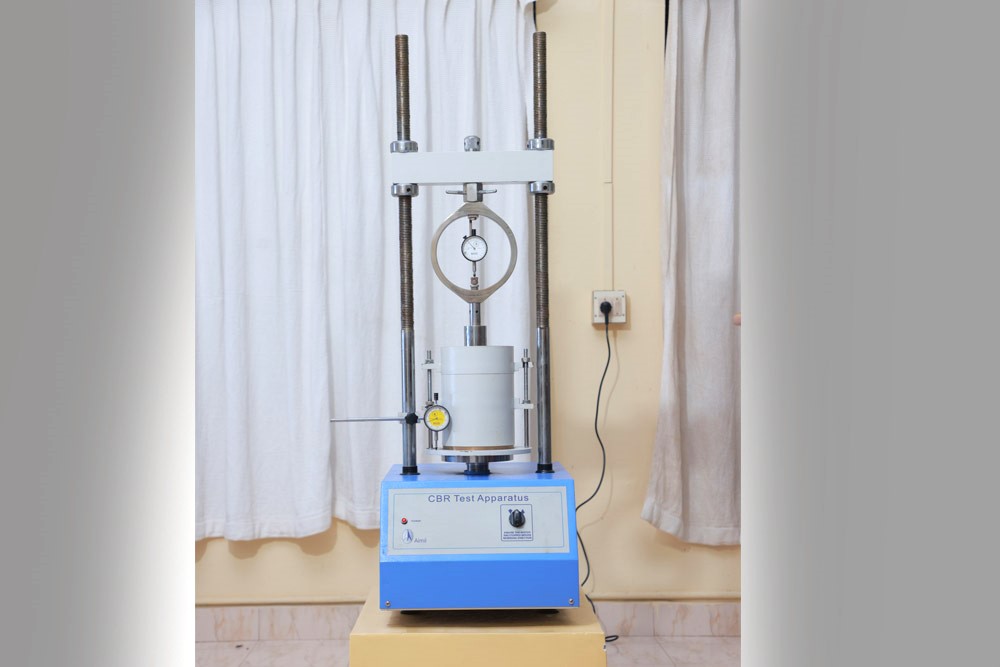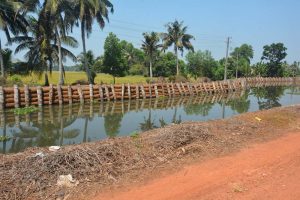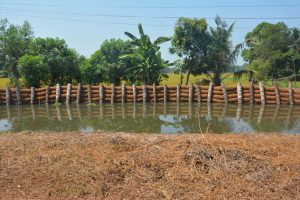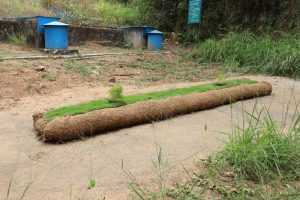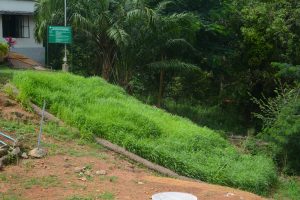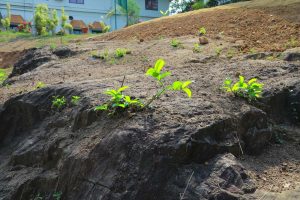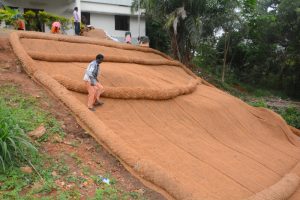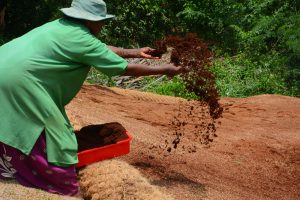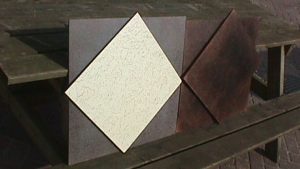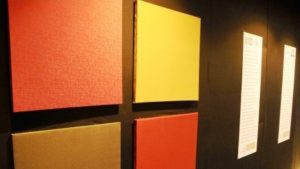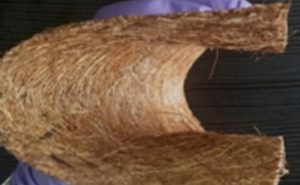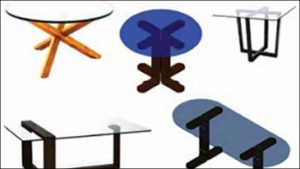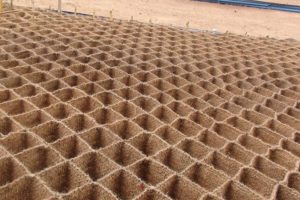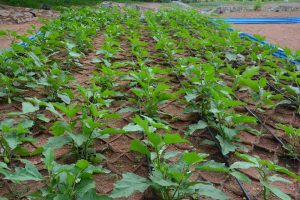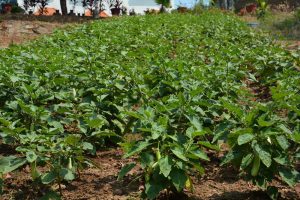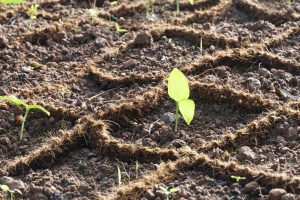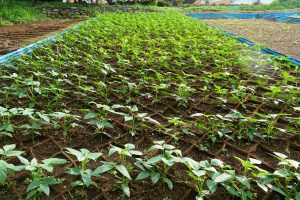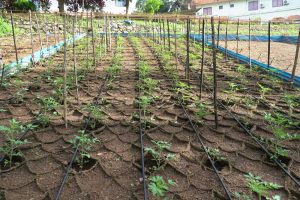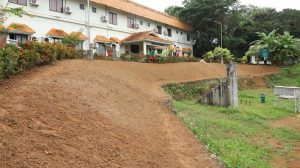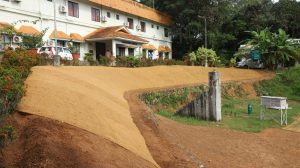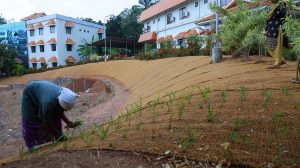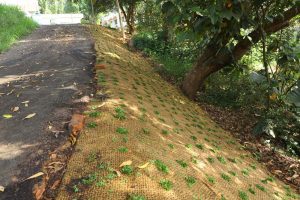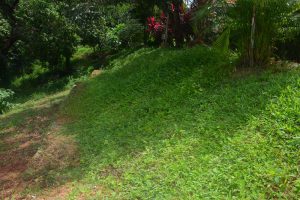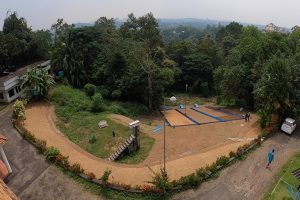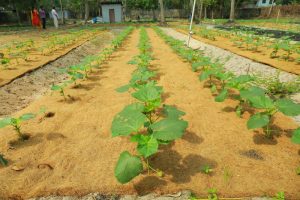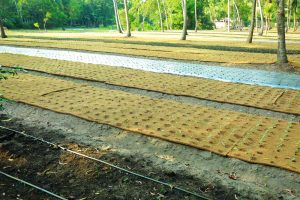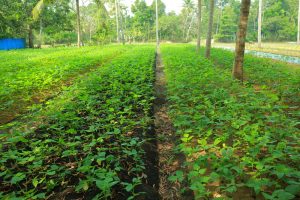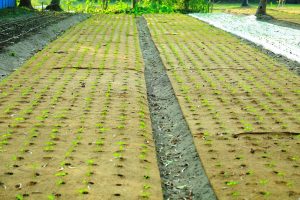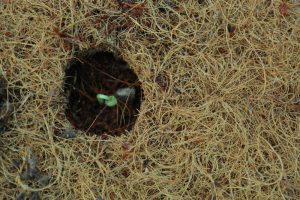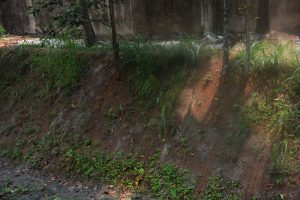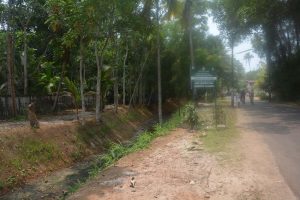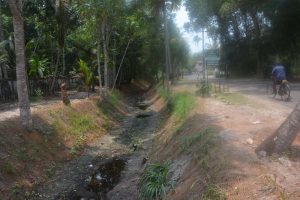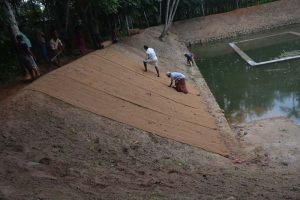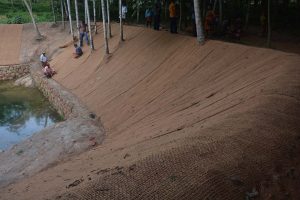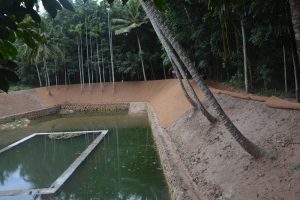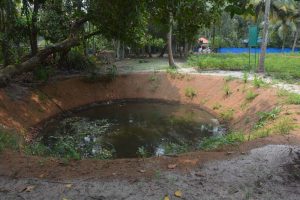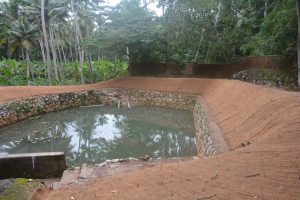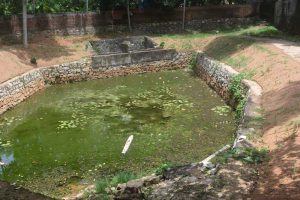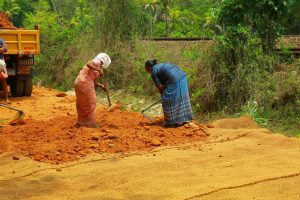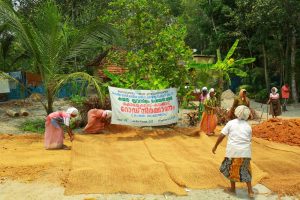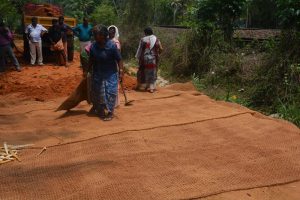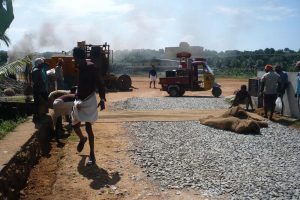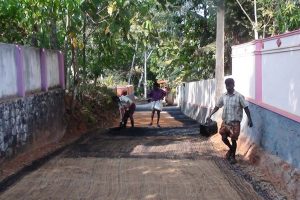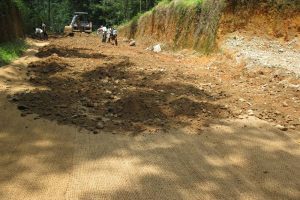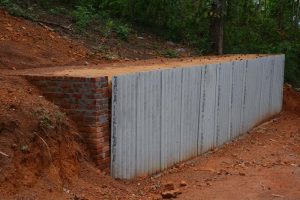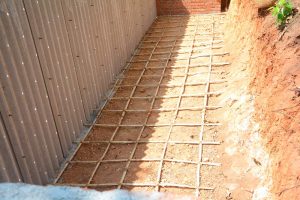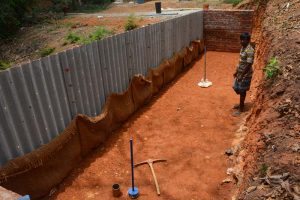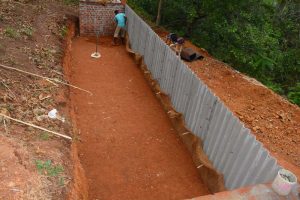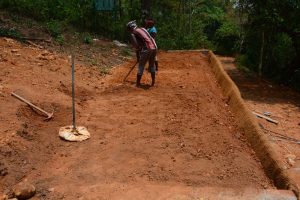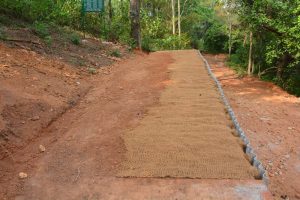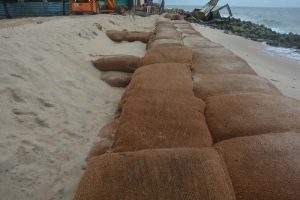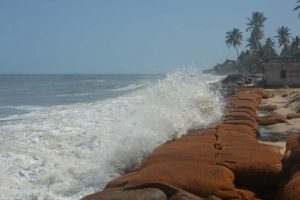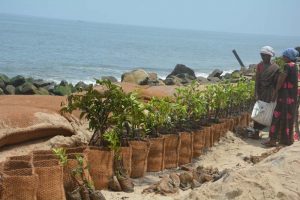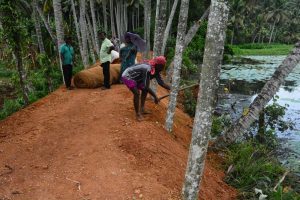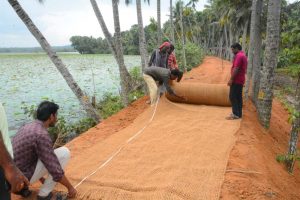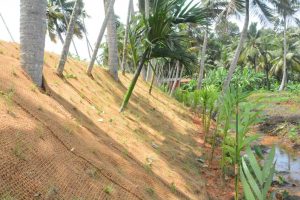About the Division
The geotechnical division caters the need of geotechnical engineering interventions pertaining to coir industry. By taking up research in the key segments of applied, developmental and operational research, the division focuses on the development and dissemination of diversified engineering applications of coir through the conduct of various demonstrative and collaborative projects. To supplement research, a well equipped geotechnical engineering laboratory is housed in NCRMI for testing of various physical and engineering properties of soil, fibre, yarn and geotextile. The laboratory is at the forefront in the facilitation of testing facility for fibre, yarn and geotextile in the state.
Canal bank protection at Nedumudi Panchayath
Strengthening of the canal bank using cocologs at Nedumudi Panchayath, Alappuzha district was envisaged for the protection of paddy field and settlements from micro flooding caused by the collapse of canal bank. For strengthening the canal bank, cocologs were used. In spite of receiving heavy rainfall, no slumping or failure was observed in the area owing to the reinforcement provided by the cocologs, which otherwise was a common phenomenon. In the region, paddy cultivation was limited to a single season in a year primarily due to micro flooding. But with the implementation of the project, the reinforcement provided to the canal bank strengthened the bank against the water pressure. Consequently, the paddy field was also well protected from otherwise intruding water. This has led to cultivation of paddy for second time in a year which was possible after a period of 15-20 years.
Development of coir road divider
The ecofriendly divider is constructed using natural materials of coir. The application of coir based material aid in easing the channelization of traffic involving lower economics. Being constructed using coir based materials; these dividers can drastically reduce the impact on collision in comparison to other dividers. These are particularly suited in regions having less availability of soil. Further, the inclusion of coir based material fosters the development of vegetation's in the dividers. This aids in reduction of quantity of soil and the irrigation water required for the growth and development of the vegetation.
Erosion control using coir geotextiles by rejuvenation of exposed rock patches
The most befitting solution for abating erosion is through vegetative establishment. This establishment is possible in a media like soil where the rooting is able to be established. But in cases of rocks, the extend of establishment is only meagre. To combat such an issue, combination of coir product can effectively be used for rejuvenation of rock patches.
Creative coir – Acoustic panel system in coir
Acoustic panel using different types of coir products of first generation were developed for interior decoration. The acoustic paneling system will serve the purpose of enhancing acoustics and will be cost effective. Preliminary prototypes of coir panels were made with available forms of coir in the market and experimented using different thickness. The same were designed in sizes and shapes to suit different instances where it could be used like false ceilings, partitions, walls etc. An eco-friendly, fire retardant, cost-effective, durable and aesthetically good product having retrofitting features, international standard for the panels, safe and organic, low cost alternative, a low NRC product was developed.
Development of coir binderless board
Coconut husk can be used as the base material for the production of environment friendly, binderless, high performance board materials. The specific chemical composition of the coir fibre, in particular its high content of lignin, can be used for the production of high quality coir fibre boards. A simple and efficient technology has been developed to produce high strength - high density board materials. The produced board material exhibited excellent properties, comparable with or even superior to commercial wood based panels. The boards can be stored on a flat surface on top of each other. The coconut husk boards can be handled with common wood working equipment for drilling, sawing and polishing.
Development of biodegradable mulching mat using coir polymer systems
To extend the service life of coir mulching mats the use of various polymers as an alternative bonding material was explored as a Collaborative project between NIIST and NCRMI. A range of systems composed of biodegradable coir and polymers as mulching sheets/mats with improved properties was developed. The coir mulch mats on laboratory scale were fabricated; both mechanical and optical characteristics were studied. Mulching mats produced from biodegradable materials like coir has several distinct advantages over conventional polymeric mulches.
Product design and development of coir fiber reinforced polymer composites for automotive and domestic applications
Eco-friendly sustainable coir fiber reinforced green composites for commercial applications were developed as part of collaborative project between CBPST and NCRMI. The application target was driven by the current needs in the automotive industry to make eco-friendly interior automotive parts. A prototype design was developed for making PP-coir composite domestic products. The products have shown excellent mechanical properties along with low water absorption value and superior hardness compared to that of other thermoplastic products. The coir based polymer composite, the new engineering application to the end uses of coir is a best wood substitute.
Coir geocell – A sustainable product for slope land stabilisation and cultivation
A pertinent solution for intense erosion on sloping topography is through vegetative establishment, wherein the soil particles bounded together by the anchorage of rooting system averting the erodibility of soil particles. To revamp such region into cultivable areas and stabilize slope, geocell systems were developed. Precipitation and topography are two major prima facia reasons of soil erosion. Regions with sloping topography coupled with high precipitation are susceptible to intense erosion leading to calamities as landslides. A pertinent solution for such occurrence is by vegetative establishment, wherein the soil particles bounded together by the anchorage of rooting system averting the erodibility of soil particles. Geocell are 3 dimensional honey comb structure made of coir geotextile which could contain soil within the cellular structure. Within the cellular confinement, crops could be cultivated which not only reduce the soil loss but also provide yield.
Slope stabilization using coir geotextiles
Coir geotextiles can effectively be used for the control of soil erosion from sloping terrain. The coir geotextile binds the soil from eroding away and promotes a suitable microclimate for the growth and development of vegetation. As the vegetation develops, it checks the soil from eroding away.
Application of coir geotextiles as mulch
Among the diversified use of coir geotextiles, its use as a protective covering to improve crop productivity and to reduce weed problems assumes to be much significant. The application of eco-friendly coir based mulching material improves the soil properties without being detrimental to nature.
Stabilization of river bank using coir geotextiles
Coir geotextile was used for the stabilization of MararikulamValiyathoodu at Alappuzha which is approximately 5 km long and having a depth of 2m from the river bottom. A slopping length of approximately 3 m required protection for the entire 5 km long river bank which was protected with coir geotextiles.
Stabilization of pond using coir geotextiles
As a demonstration project stabilisation of pond was conducted using coir geotextiles to establish permanent vegetation which will act as a recharge basin and enhance ground water recharge.
Construction of road using coir geotextiles
Coir geotextiles can act as a separation cum drainage layer and also serve the function of reinforcement in pavement.
Roads stabilised using coir geotextile
- Konni-Poonkavu main road to Rajiv Gandhi Indoor Stadium open ground (50 m)
- Kottarathilpadi- Nalloorpadi road at Enadimangalampanchayath(440 m)
- Kucha road at Mararikkulam, Komalaparambu – Kulakad road (320 m)
- Kucha road at Mararikkulam, Krishibhavan – Naduvilezhath road (300 m)
- Ambedkar colony road at VallikodePanchayath (570 m)
- NCRMI campus road (345 m)
- Puthenvilappadi – Kolappara road at VallikodePanchayath (537 m)
Construction of retaining wall using bamboo coir composites
With a view to make use of the inherent qualities of coir in the best manner possible, bamboo with coir interface was used as reinforcement for the construction of retaining walls. The added advantage of bamboo- coir composite is high strength to weight ratio for fabrication cost and reduced maintenance. Similarly construction of retaining wall of moderate height can be efficiently carried out by bamboo with coir interface.
Demonstration project on sea shore protection using latex bags at Mararikulam South Grama Panchayath
Coastal erosion becomes a hazard where human activity is threatened by a temporary or permanent hold back of the shoreline. Apart from the regular uses, geosystems made with geotextiles like geotextile bags plays a proactive role in hydraulic, coastal, offshore engineering as eco-friendly, construction friendly and cheaper alternatives of the traditional protection and engineering solutions which generally are hard, short lived, expensive and torment nature.
Earthen bund protection
Coir geotextile paves a way in reducing failures of earthern bund through reinforcement and strengthening. With its innate properties of soil binding and drainage, coir geotextiles when laid stabilizes and strengthens the bund while permitting the establishment of vegetation.
Use of coir fibre as reinforcing material in cement mortar
The collaborative project between NCRMI and CUSAT explored the potential of natural fibre in inhibiting crack propagation and enhancing the mechanical properties of binders in cement concrete.
Development of polymer coir composites for electrical insulation
The collaborative project between NIIST and NCRMI explored process technology to develop electrical insulating thermoset polymer composites using treated/untreated coir fibers, reduced partial discharge and dielectric loss factor, higher mechanical and thermal stability, etc, to develop prototypes, validation and testing and demonstration for high voltage insulation applications.
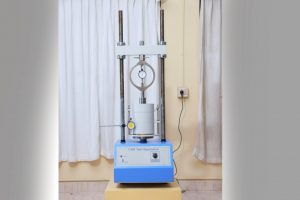 CBR Test Apparatus
CBR Test Apparatus
For determining the California Bearing Ratio and expansion characteristics under known surcharge weight of base, sub-base and subgrade soils for the design of roads, pavements and runways.
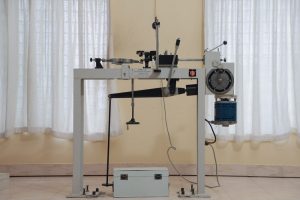
Direct Shear Apparatus
Determination of the shear strength and shear parameters of soil.
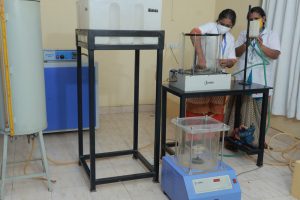 Geotextile Permeability
Geotextile Permeability
To determine the permittivity of geotextile, either by using constant head or falling head test procedures.
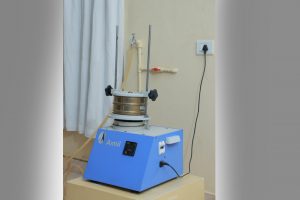
Sieve Analysis Apparatus
Determination of the gradation of the soil particles.
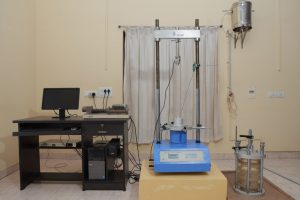 Triaxial Test Apparatus
Triaxial Test Apparatus
For conducting triaxial shear test on soil specimens while the specimen is under confining pressures on all sides.
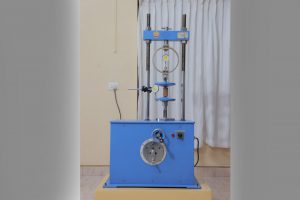
Unconfined Compression Test Apparatus
For determining the maximum axial compressive stress that a cohesive soil specimen can bear under zero confining stress.
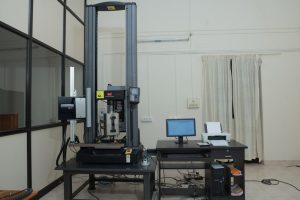 Universal Testing Machine (Instron 5969)
Universal Testing Machine (Instron 5969)
The equipment is used for the evaluation of tenacity, breaking load etc. of fibre, yarn and geotextile. The equipment offers various test methods and being software driven, it provides live test result during the test.
Training on canal bank protection using coir geotextiles in Mambra Nalucent Colony, Karumalloor Grama Panchayath
The training programme on canal bank protection using coir geotextiles was conducted for MGNREGA workers in Mambra Nalucent Colony, Karumalloor Grama Panchayath. The technical session was followed by field training at the project site. The Scientists and Technical Officers from NCRMI demonstrated the laying of coir geotextiles in the field to MGNREGA labourers.
Training to engineers of Public Works execution and management, Department of Agriculture Development & Farmers Welfare
NCRMI conducted two days training to Assistant Engineers, Assistant Executive Engineers of Department of Agriculture Development & Farmers Welfare. The training included an overall insight on coir geotextiles and technical sessions on environmental friendly applications of coir geotextiles, estimation etc. Field visit and hands on training was also given on laying of coir geotextiles in field.
Training on uses and established application of coir geotextiles
Conducted 9 batches of training, consisting of 324 trainees on the uses and field application of coir geotextiles. The trainees were Accredited Engineers and Overseers from MGNREGS, Department staffs and staffs of coir PSU’s. Training was given to the Officials on theory and practical sessions on coir geotextiles.
Summer internship programme for M. Tech geotechnical engineering students of Department of Civil Engineering, College of Engineering Trivandrum
NCRMI conducted two days Summer Internship Programme for Post graduate M Tech Geotechnical Engineering students of Department of Civil Engineering, College of Engineering Trivandrum. The training was conducted in two batches and the program encompassed lecture on various topics including an overview on coir geotextiles – functions and environmental friendly applications, field visit to demonstration project sites geotextile testing etc. As part of the program detailed class and demonstration on the working of all conventional geotechnical lab equipment in NCRMI laboratory was illustrated.
National seminar on uses & established applications of coir geotextiles
NCRMI in association with Mararikulam North Grama Panchayat organized a national level seminar on “Uses & Established Applications of Coir Geotextiles” on 4th & 5th February, 2017. The technical seminar held on 4th Feb, 2017. The seminar paved way for the exchange of ideas on the practical implementation of established coir geotextiles applications by different Govt. Department and by other stakeholder agencies. Seminar proved instrumental in bringing together academicians, researchers and experts from different parts of the country for in-depth analysis on various developments on coir geotextiles. The four full-fledged sessions by eminent speakers showered light on the coir geotextiles application in road construction, river bank protection, erosion control and agriculture wherein officials, Engineers of LSGD, Irrigation Dept., Agricultural Dept., PWD, Coir Exporters, Coir officials Coir Board, CCRI etc. participated. This interactive cum demonstration seminar ensured an active participation of more than 1200 Panchayat Raj Institution leaders from across the State, Coir officials, stake holders etc.
International and national seminar of coir kerala 2019
As part of Coir Kerala 2019, an International and National seminar was conducted at Alleppey from 04.12.2019 to 08.12.2019. The theme of Coir Kerala 2019 is “Innovations in Coir” which vividly depicts the agenda of reorganisation plan. International and National seminar on following areas were conducted – Coir innovative products and utilisation possibilities, coir binderless boards, coir acoustic boards, evolution of coir machinery, biodegradable mulching mat using coir, polymer coir composites for furniture applications, coir composites for domestic and automotive application, role of startups in coir sector, domestic market for coir products, seminar on heritage museum, coir geotextile for soil water conservation, entrepreneurs meet – fibre production. Eminent speakers, Scientists, Policy makers, Academicians, Govt. Officials, Industrialists, and Research Scholars participated in the International and National Seminar.
- Sri. Abhishek C, Scientist S3
- Smt Sibi Joy, Scientist S2 (R&D)
- Sri Aneesh R, Technical Officer (Civil)
- Sri Jithu P. Ajith, Technical Officer (Agricultural Engg.)

